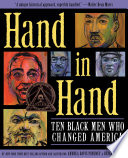Surveyor of the Sky
BENJAMIN BANNEKER WAS BORN under a lucky star. Came into this world a freeborn child, a blessing bestowed on few of his hue. In Colonial America, most black people were enslaved. But Benjamin’s grandmother, Molly, was an indentured dairymaid from England who had obtained her freedom. Molly and Benjamin’s mother, Mary, had both lived as free women in the colony of Maryland.
In 1730 Mary wed a former slave named Robert, a black man from West Africa. Robert had been granted his freedom by a master who let his slaves go if they agreed to become Christians. As soon as this offer was presented to Robert, he put his hand on the Holy Bible, said amen, thanked the good Lord, waved good bye to his master, and gave freedom a hello
hug.
Mary and Robert welcomed Benjamin a year after they married, in 1731. Then came Benjamin’s three younger sisters: Minta, Molly, and a third little girl whose name is no longer known. The Banneker children had official papers that spelled out their
freedom.
Mary and Robert saved enough money to buy a plot of land for growing tobacco. Their hundred-acre farm stood at the mouth of Maryland’s Chesapeake Bay. The Bannekers named their place Stout, on account of their prosperous crops, and as a reflection of the hefty dose of love they had for each other and their children.
As soon as he could talk, Benjamin’s grandma Molly started to teach him to read the only book she owned, the Bible. She also showed her grandson how to write. From the Bible, Benjamin learned everything from the begats to the Beatitudes. And by reciting all one hundred and fifty psalms, Benjamin discovered he could
count.
Soon the boy knew numbers as well as he knew his name. For fun, he taught his sisters to count all ten fingers, every toe, and each of their new teeth.
Benjamin didn’t have many friends his own age. His sisters were his only playmates. Because there weren’t many other free blacks in America-and because Robert feared he could be thrown back into slavery-Benjamin, his sisters, and their parents tended to their land without much socializing.
They enjoyed their time together as a family. Working tobacco was no easy feat, but the Bannekers made the days go faster by singing as they worked.
In the spring it was Benjamin’s job to pick slugs and bugs from the tobacco shoots. When August brought on days hotter than the hinges on the sun’s front door, it was time for the tobacco harvest. Benjamin helped collect tobacco leaves, hang them to dry, then roll them into hogshead bundles.
These were big chores for a little kid. Benjamin turned his work into a game by telling his ma how many there were of anything worth counting-clouds, twigs, pigs, haystacks, horseshoes, beetles, blue jays. Soon Benjamin could add and subtract, and find the rhythms of arithmetic. Math was no chore for Benjamin. Numbers were fun. As Benjamin grew, so did his
curiosity.
When the sun set each day, and stars pressed their diamond eyes through the curtain of the sky, Benjamin counted them,too.
The beauty of those stars inspired Benjamin to wish, and to wonder:
When stars change their places in the sky each night, are they dancing while shining? W
hat makes the moon go from a ball of butter to an archer’s bow, then leave the sky a blackened cape?
How does the sun know to rise each day, sit high at noon, and set at dusk?
These questions stayed with Benjamin. They were mysteries that he wanted to solve.
When Benjamin was grown, Mary and Robert let him run the family farm. He kept Stout going, building it into one of the heartiest tobacco enterprises along the Chesapeake Bay. By this time Benjamin enjoyed reading newspapers. Benjamin had taught himself geometry, algebra, and statistics. He was what nowadays we’d call a math-happy man. He even devised a plan for making tobacco farming more efficient by breaking the process into thirty-six steps.
Benjamin was a tinkerer, too. When a fence post or a hoe broke, he was quick to figure out how to fix it. If an oxcart wheel was missing a spoke, Benjamin did more than replace the wheel he took all four wheels off the cart, constructed new ones with better traction, came up with a special design for the oxen’s yoke, and trained the ox to step up his stride so the cart moved faster.
For most farmers, days were run by the rising and setting of the sun. Every waking moment was devoted to hauling, rinsing, rolling, and stacking tobacco leaves. When dawn broke, folks woke. When morning lit the day, farm chores were well underway. When the sun was highest in the sky, it was time for poached poultry, turnips, and collard greens-enough lunch to get through an afternoon of more hard work. As soon as dusk came, so did the stove’s fire for baking an ash cake that would be served with molasses and milk before bed.
Comprehension Questions
1. What company was built along the Chesapeake Bay?
A. Tobacco enterprise
B. Alcohol enterprise
C. Clothes enterprise
A. His brothers
B. His sisters
C. His cousins
Your Thoughts
Vocabulary
4. List any vocabulary words below.

